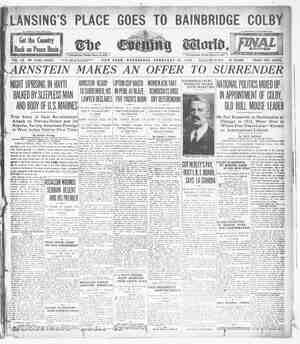New Britain Herald Newspaper, February 25, 1920, Page 9
You have reached the hourly page view limit. Unlock higher limit to our entire archive!
Subscribers enjoy higher page view limit, downloads, and exclusive features.
BRITAR DAILY HERALD WEDNESDAY, FEBRUARY 25 1920. The “WHY” of the Demand Charge Lach Consumer Has a Part of the Electric Company’s Plant Facilities Reserved for His Particular Demand Back of that little electric ‘wire running into your house is an im- mense network of machinery, man-power and detail of which you may not be aware because you cannot see it. Most persons just take it for oranted that the *‘juice” is in the wire—very much as if it ar- rive- there out of the air. 3 But down at the power plant, at the other end of the wire, yvou would see that it is no simple matter to produce and deliver electric current for a large population, to be drawn upon in any volume, at any moment, day or night. And it's decidedly expensive. -Electricity is not made in quantities and stored for future sale, like the o0ods on the merchant’s sh=lves. The merchant, buying that wav and selling the goods from time to time, can take advantage of the bast purchase price and can command the best selling price. On the other hand. electricity is manufactured as used. It cannot be stored up for future sale. The electric company cannot wait for a more favorable “market.” Today’'s needs must be met today, at whatever cost. And what are these needs? Not, as some think. the actual nmount of current consumed. This amount varies greatly. At times the consumption takes a sudden radical jump—due to quick weather change or other cause—and the electricity must be in the wires to meet it. And it may dro» suddenly: but we have gone to the expense of providing for possible use of our resources just the same. So we cannot count upon a minimum demand upon our facil- ities. Neither do we assume a matimum demand. But, from long experience, we are able to determine the normal maximum demand. Anfluupon this we base the amoun* of electricity we must keep ‘‘on tap. This normal call upon the resources of an electric company is known as the “demand.” Under the new electric rates, each con- sumer is asked to pay his small portion of the “demand’ expenses. Let 11s give you briefly an idea of what these expenses are: Biggest item of all—running into the millions—is the cost of our vlant. ‘machinery, wires, poles and similar facilities. Interest on this investment, which was made to provide for each consumer’s ‘‘de- mand,” runs into large figures. Upkeep of the property—repairs to wires, poles. machinery— maintenance in all its complicate i “has-c ave o constant source of expense. Taxes is another large item and one that is always on the increase. Then there is labor. Our large force must be on the job all the time. They must be paid for every day and every hour, even though at particular times our consumers make little use of current. And thev are paid well. Which accounts for their faithful, c8nscientious work in your service. It would be easier for us to cover these “demand’” expenses by a flat increase in electric rates. But we believe it to be more just to all consrmers to charge each one according to his particular ‘‘demand.” The cost of being ready to serve any house depends largely upon the space in the house which is electrically equipped. In arriving at this space, we do not include the cellar, closets. unfinished attic or places where there would be no ‘‘demand” for electricity. We take the number of square feet of space in the finished rooms and call that the “demand’” area. Then a slight charge is made to each consumer each month based upon his particular ‘‘demand.” After the Service Charge (which is the total of the ““Consumer™ and “Demand” Charges) has been met, we sell you electricity at abont half the former rate per kilowatt hour. It is merely an equalizing plan. It does not favor any class. Nor does it impose a hardship on any class. The “little fellow’* may ben- efit—indeed, is quite likely to. If he has a small “demand” area, his demand charge is correspondingly small, and if he uses a reasonable amownt of electricity for the soace. he gets it for much less money, including the service charge, than he would have paid for the same amqount under the former rate. But if he is satisfied with small or infrequent use of electricity, the service charge may make his bill higker than before. . It is just the same with the larse house owner. He pays the same “demand’” charge ver 100 square fzet as does the small householder, and whether his bills will be higher or lower than before depends whollv upon the consumption. Fairness to all, and no discrimination, is the idea back of the “De- mand” Charge. You can solve the servant problem—You can make your house- work easier—You can have an abu~dance of light and enjoy electrical helps and labor-saving devices, =t 223 coct than ever before—under the new electric rates. To KNOW the “‘Service-Charge” Plan is to APPROVE It THE CONNECTICUT LIGHT and POWER co.






